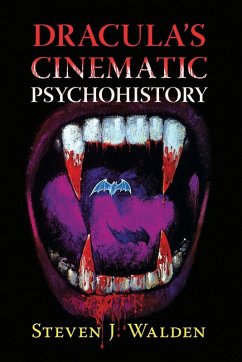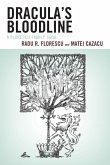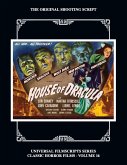Steven J Walden
Dracula's Cinematic Psychohistory
Steven J Walden
Dracula's Cinematic Psychohistory
- Broschiertes Buch
- Merkliste
- Auf die Merkliste
- Bewerten Bewerten
- Teilen
- Produkt teilen
- Produkterinnerung
- Produkterinnerung
Dracula is a recognized, resilient and recurrent cultural property. He is idolized, loved, vilified and hated as a multifaceted, perennial narrative focus that involves the interplay between film-as-art and its psychosocial milieu. Dracula's movies can thus be read as a cultural barometer, reflecting the culture we create and re-create in his many cinematic guises: an object of attraction and terror, antihero and villain, lover and monster, even victim and stooge. This book follows Dracula's cinematic journey, exploring how he continues to tap into the ever-changing collective psyche of his…mehr
Andere Kunden interessierten sich auch für
![Dracula's Bloodline Dracula's Bloodline]() Radu R. FlorescuDracula's Bloodline57,99 €
Radu R. FlorescuDracula's Bloodline57,99 €![DC Cinematic Universe DC Cinematic Universe]() Nick JonesDC Cinematic Universe22,99 €
Nick JonesDC Cinematic Universe22,99 €![House of Dracula House of Dracula]() Philip J RileyHouse of Dracula26,99 €
Philip J RileyHouse of Dracula26,99 €![The Cinema of James Wan The Cinema of James Wan]() The Cinema of James Wan55,99 €
The Cinema of James Wan55,99 €![The Screen Chills Companion, 1931-1939 The Screen Chills Companion, 1931-1939]() Chris FellnerThe Screen Chills Companion, 1931-193952,99 €
Chris FellnerThe Screen Chills Companion, 1931-193952,99 €![Queer Screams Queer Screams]() Abigail WaldronQueer Screams45,99 €
Abigail WaldronQueer Screams45,99 €![The First Star Trek Movie The First Star Trek Movie]() Sherilyn ConnellyThe First Star Trek Movie44,99 €
Sherilyn ConnellyThe First Star Trek Movie44,99 €-
-
-
Dracula is a recognized, resilient and recurrent cultural property. He is idolized, loved, vilified and hated as a multifaceted, perennial narrative focus that involves the interplay between film-as-art and its psychosocial milieu. Dracula's movies can thus be read as a cultural barometer, reflecting the culture we create and re-create in his many cinematic guises: an object of attraction and terror, antihero and villain, lover and monster, even victim and stooge. This book follows Dracula's cinematic journey, exploring how he continues to tap into the ever-changing collective psyche of his viewers. Many of those viewers may have entertained the thought that the fearful bite of the vampire might just be a worthwhile price to pay for the empowerment of being one.
Produktdetails
- Produktdetails
- Verlag: McFarland & Co Inc
- Seitenzahl: 276
- Erscheinungstermin: 11. September 2025
- Englisch
- Abmessung: 229mm x 152mm x 15mm
- Gewicht: 410g
- ISBN-13: 9781476693064
- ISBN-10: 1476693064
- Artikelnr.: 73873622
- Herstellerkennzeichnung
- Libri GmbH
- Europaallee 1
- 36244 Bad Hersfeld
- gpsr@libri.de
- Verlag: McFarland & Co Inc
- Seitenzahl: 276
- Erscheinungstermin: 11. September 2025
- Englisch
- Abmessung: 229mm x 152mm x 15mm
- Gewicht: 410g
- ISBN-13: 9781476693064
- ISBN-10: 1476693064
- Artikelnr.: 73873622
- Herstellerkennzeichnung
- Libri GmbH
- Europaallee 1
- 36244 Bad Hersfeld
- gpsr@libri.de
Steven J. Walden is a film theorist and social historian, UK CertFAIII forensic anthropologist, Royal Society of Biology chartered biologist, and registered intellectual disabilities nurse. He is a PhD advisor with wide ranging research interests, holds PhDs in forensic anthropology and film history, and currently teaches intellectual disabilities nursing at the University of South Wales, Pontypridd, where he is a member of several research groups and works with the USW Cold Case Unit on found human remains casework.
Table of Contents Preface Section I-Introducing Dracula's Cinematic Psychohistory 1.
Introduction Resurrections and Repercussions Why This Book? 2.
Historicism and Psychohistoricism Reading Movies from the Psychohistoricist Perspective 3.
Dracula and Vampire Theory Section II-Universal Dracula: The 1930s and 1940s 4.
The Universal Dracula Cycle 5.
Psychoanalytic Symbolism in Browning's and Melford's 1931 Dracula Movies The Penetrating Gaze, Abusive Scopophilia, Sublimation and Retribution Dracula and Other Gangsters from the Id 6.
The Psychological Drama of Son of Dracula Bad Father, Worse Daughter Freud's Psychopathic Femme Fatale on the Stage 7.
The Monster Rallies: Locating Dualism in Kenton's Universal Horror Films Personas, Shadows and Uncanny Doubles Monstrous Queer Pathology and Persecution during World War II 8.
The Universal Dracula Movies: The Psychohistoricism of the Cycle Section III-Dracula Reinvented: The Long 1960s
9.
The Hammer Dracula Cycle: 1958-1972 Hutchings, Psychohistoricism and Hammer's Dracula Coalescing Psychoanalytical Symbolism in Hammer's Dracula Cycle 10.
Dracula at the End of the Long 1960s Psychosexual Symbolism in Franco's Bram Stoker's Count Dracula (1970) Outlining Narcissistic Rage in Dan Curtis' Bram Stoker's Dracula (1973) Threads of Commonality 11.
A Trajectory of Narcissism: Hammer's Dracula and the Cult of the Vampire Libertine Franco's Ageless Dracula: Preserving the Self by Controlling Others Narcissistic Leaders' Rage in Three Draculas of the Long 1960s Benign Narcissism and a Counterculture Fear of Death Malign Narcissism and the Fear of the Cult Leader 12.
Fear of Death and Fear of Dracula in the Long 1960s Cycle of Movies Section IV-The Long 1980s: Obsolescence, Reconstruction and Sympathy for the Vampire 13.
The Long 1980s Dracula Movie Cycle 14.
The Return of Repressive Symbolism in John Badham's Dracula (1979) The Superphallic Patriarch versus the Polyphallic Feminist The Ego State of Vampirized Feminism at the Beginning of the Long 1980s 15.
Symbolizing the Monstrous Feminine in The Monster Squad's Narrative An Oedipal Voyage Around Three Fathers Therapy Culture for Dracula's Diminished Self? No Fear for Generation X 16.
Blood Sacrifice in Coppola's Bram Stoker's Dracula (1992) Dracula's Freudian Melancholy Resolved Dracula, Degenerative Disease and the Fin de Siècle 17.
Loss of Fear: The Long 1980s Dracula Movies as a Cycle of Change Section V-The Postmillennial Cycle: Dracula Becomes the Hero 18.
Traitors, Dictators and Superheroes 19.
Dracula 2000: The Dead Father's Return and the Birth of a Superhero A Hollow Oedipal Victory over Millenarianism Dracula's Neofascist Millenarianism 20.
The Return to Dyadic Repression in Sommers' Van Helsing (2004) A Problematic Recovery from Repression Somatizing Guilt in Unjust Wars 21.
Freudian Totemic Oedipality in Dario Argento's Dracula (2012) The Omnipotence of Argento's Narcissistic Benevolent Dictator Dracula and the Neofascist Legacy of Italian Populism 22.
Superhero Identity in Gary Shore's Dracula Untold (2014) The Repressed Superhero Unmasked Dracula Retold as a Mythic Tragedy of Leadership 23.
The Postmillennial Dracula Cinematic Cycle: Lost Fear and the Leadership of the Other Conclusion: Loss of Fear and Gaining Sympathy as Cycles Intersect Filmography Bibliography Index
Introduction Resurrections and Repercussions Why This Book? 2.
Historicism and Psychohistoricism Reading Movies from the Psychohistoricist Perspective 3.
Dracula and Vampire Theory Section II-Universal Dracula: The 1930s and 1940s 4.
The Universal Dracula Cycle 5.
Psychoanalytic Symbolism in Browning's and Melford's 1931 Dracula Movies The Penetrating Gaze, Abusive Scopophilia, Sublimation and Retribution Dracula and Other Gangsters from the Id 6.
The Psychological Drama of Son of Dracula Bad Father, Worse Daughter Freud's Psychopathic Femme Fatale on the Stage 7.
The Monster Rallies: Locating Dualism in Kenton's Universal Horror Films Personas, Shadows and Uncanny Doubles Monstrous Queer Pathology and Persecution during World War II 8.
The Universal Dracula Movies: The Psychohistoricism of the Cycle Section III-Dracula Reinvented: The Long 1960s
9.
The Hammer Dracula Cycle: 1958-1972 Hutchings, Psychohistoricism and Hammer's Dracula Coalescing Psychoanalytical Symbolism in Hammer's Dracula Cycle 10.
Dracula at the End of the Long 1960s Psychosexual Symbolism in Franco's Bram Stoker's Count Dracula (1970) Outlining Narcissistic Rage in Dan Curtis' Bram Stoker's Dracula (1973) Threads of Commonality 11.
A Trajectory of Narcissism: Hammer's Dracula and the Cult of the Vampire Libertine Franco's Ageless Dracula: Preserving the Self by Controlling Others Narcissistic Leaders' Rage in Three Draculas of the Long 1960s Benign Narcissism and a Counterculture Fear of Death Malign Narcissism and the Fear of the Cult Leader 12.
Fear of Death and Fear of Dracula in the Long 1960s Cycle of Movies Section IV-The Long 1980s: Obsolescence, Reconstruction and Sympathy for the Vampire 13.
The Long 1980s Dracula Movie Cycle 14.
The Return of Repressive Symbolism in John Badham's Dracula (1979) The Superphallic Patriarch versus the Polyphallic Feminist The Ego State of Vampirized Feminism at the Beginning of the Long 1980s 15.
Symbolizing the Monstrous Feminine in The Monster Squad's Narrative An Oedipal Voyage Around Three Fathers Therapy Culture for Dracula's Diminished Self? No Fear for Generation X 16.
Blood Sacrifice in Coppola's Bram Stoker's Dracula (1992) Dracula's Freudian Melancholy Resolved Dracula, Degenerative Disease and the Fin de Siècle 17.
Loss of Fear: The Long 1980s Dracula Movies as a Cycle of Change Section V-The Postmillennial Cycle: Dracula Becomes the Hero 18.
Traitors, Dictators and Superheroes 19.
Dracula 2000: The Dead Father's Return and the Birth of a Superhero A Hollow Oedipal Victory over Millenarianism Dracula's Neofascist Millenarianism 20.
The Return to Dyadic Repression in Sommers' Van Helsing (2004) A Problematic Recovery from Repression Somatizing Guilt in Unjust Wars 21.
Freudian Totemic Oedipality in Dario Argento's Dracula (2012) The Omnipotence of Argento's Narcissistic Benevolent Dictator Dracula and the Neofascist Legacy of Italian Populism 22.
Superhero Identity in Gary Shore's Dracula Untold (2014) The Repressed Superhero Unmasked Dracula Retold as a Mythic Tragedy of Leadership 23.
The Postmillennial Dracula Cinematic Cycle: Lost Fear and the Leadership of the Other Conclusion: Loss of Fear and Gaining Sympathy as Cycles Intersect Filmography Bibliography Index
Table of Contents Preface Section I-Introducing Dracula's Cinematic Psychohistory 1.
Introduction Resurrections and Repercussions Why This Book? 2.
Historicism and Psychohistoricism Reading Movies from the Psychohistoricist Perspective 3.
Dracula and Vampire Theory Section II-Universal Dracula: The 1930s and 1940s 4.
The Universal Dracula Cycle 5.
Psychoanalytic Symbolism in Browning's and Melford's 1931 Dracula Movies The Penetrating Gaze, Abusive Scopophilia, Sublimation and Retribution Dracula and Other Gangsters from the Id 6.
The Psychological Drama of Son of Dracula Bad Father, Worse Daughter Freud's Psychopathic Femme Fatale on the Stage 7.
The Monster Rallies: Locating Dualism in Kenton's Universal Horror Films Personas, Shadows and Uncanny Doubles Monstrous Queer Pathology and Persecution during World War II 8.
The Universal Dracula Movies: The Psychohistoricism of the Cycle Section III-Dracula Reinvented: The Long 1960s
9.
The Hammer Dracula Cycle: 1958-1972 Hutchings, Psychohistoricism and Hammer's Dracula Coalescing Psychoanalytical Symbolism in Hammer's Dracula Cycle 10.
Dracula at the End of the Long 1960s Psychosexual Symbolism in Franco's Bram Stoker's Count Dracula (1970) Outlining Narcissistic Rage in Dan Curtis' Bram Stoker's Dracula (1973) Threads of Commonality 11.
A Trajectory of Narcissism: Hammer's Dracula and the Cult of the Vampire Libertine Franco's Ageless Dracula: Preserving the Self by Controlling Others Narcissistic Leaders' Rage in Three Draculas of the Long 1960s Benign Narcissism and a Counterculture Fear of Death Malign Narcissism and the Fear of the Cult Leader 12.
Fear of Death and Fear of Dracula in the Long 1960s Cycle of Movies Section IV-The Long 1980s: Obsolescence, Reconstruction and Sympathy for the Vampire 13.
The Long 1980s Dracula Movie Cycle 14.
The Return of Repressive Symbolism in John Badham's Dracula (1979) The Superphallic Patriarch versus the Polyphallic Feminist The Ego State of Vampirized Feminism at the Beginning of the Long 1980s 15.
Symbolizing the Monstrous Feminine in The Monster Squad's Narrative An Oedipal Voyage Around Three Fathers Therapy Culture for Dracula's Diminished Self? No Fear for Generation X 16.
Blood Sacrifice in Coppola's Bram Stoker's Dracula (1992) Dracula's Freudian Melancholy Resolved Dracula, Degenerative Disease and the Fin de Siècle 17.
Loss of Fear: The Long 1980s Dracula Movies as a Cycle of Change Section V-The Postmillennial Cycle: Dracula Becomes the Hero 18.
Traitors, Dictators and Superheroes 19.
Dracula 2000: The Dead Father's Return and the Birth of a Superhero A Hollow Oedipal Victory over Millenarianism Dracula's Neofascist Millenarianism 20.
The Return to Dyadic Repression in Sommers' Van Helsing (2004) A Problematic Recovery from Repression Somatizing Guilt in Unjust Wars 21.
Freudian Totemic Oedipality in Dario Argento's Dracula (2012) The Omnipotence of Argento's Narcissistic Benevolent Dictator Dracula and the Neofascist Legacy of Italian Populism 22.
Superhero Identity in Gary Shore's Dracula Untold (2014) The Repressed Superhero Unmasked Dracula Retold as a Mythic Tragedy of Leadership 23.
The Postmillennial Dracula Cinematic Cycle: Lost Fear and the Leadership of the Other Conclusion: Loss of Fear and Gaining Sympathy as Cycles Intersect Filmography Bibliography Index
Introduction Resurrections and Repercussions Why This Book? 2.
Historicism and Psychohistoricism Reading Movies from the Psychohistoricist Perspective 3.
Dracula and Vampire Theory Section II-Universal Dracula: The 1930s and 1940s 4.
The Universal Dracula Cycle 5.
Psychoanalytic Symbolism in Browning's and Melford's 1931 Dracula Movies The Penetrating Gaze, Abusive Scopophilia, Sublimation and Retribution Dracula and Other Gangsters from the Id 6.
The Psychological Drama of Son of Dracula Bad Father, Worse Daughter Freud's Psychopathic Femme Fatale on the Stage 7.
The Monster Rallies: Locating Dualism in Kenton's Universal Horror Films Personas, Shadows and Uncanny Doubles Monstrous Queer Pathology and Persecution during World War II 8.
The Universal Dracula Movies: The Psychohistoricism of the Cycle Section III-Dracula Reinvented: The Long 1960s
9.
The Hammer Dracula Cycle: 1958-1972 Hutchings, Psychohistoricism and Hammer's Dracula Coalescing Psychoanalytical Symbolism in Hammer's Dracula Cycle 10.
Dracula at the End of the Long 1960s Psychosexual Symbolism in Franco's Bram Stoker's Count Dracula (1970) Outlining Narcissistic Rage in Dan Curtis' Bram Stoker's Dracula (1973) Threads of Commonality 11.
A Trajectory of Narcissism: Hammer's Dracula and the Cult of the Vampire Libertine Franco's Ageless Dracula: Preserving the Self by Controlling Others Narcissistic Leaders' Rage in Three Draculas of the Long 1960s Benign Narcissism and a Counterculture Fear of Death Malign Narcissism and the Fear of the Cult Leader 12.
Fear of Death and Fear of Dracula in the Long 1960s Cycle of Movies Section IV-The Long 1980s: Obsolescence, Reconstruction and Sympathy for the Vampire 13.
The Long 1980s Dracula Movie Cycle 14.
The Return of Repressive Symbolism in John Badham's Dracula (1979) The Superphallic Patriarch versus the Polyphallic Feminist The Ego State of Vampirized Feminism at the Beginning of the Long 1980s 15.
Symbolizing the Monstrous Feminine in The Monster Squad's Narrative An Oedipal Voyage Around Three Fathers Therapy Culture for Dracula's Diminished Self? No Fear for Generation X 16.
Blood Sacrifice in Coppola's Bram Stoker's Dracula (1992) Dracula's Freudian Melancholy Resolved Dracula, Degenerative Disease and the Fin de Siècle 17.
Loss of Fear: The Long 1980s Dracula Movies as a Cycle of Change Section V-The Postmillennial Cycle: Dracula Becomes the Hero 18.
Traitors, Dictators and Superheroes 19.
Dracula 2000: The Dead Father's Return and the Birth of a Superhero A Hollow Oedipal Victory over Millenarianism Dracula's Neofascist Millenarianism 20.
The Return to Dyadic Repression in Sommers' Van Helsing (2004) A Problematic Recovery from Repression Somatizing Guilt in Unjust Wars 21.
Freudian Totemic Oedipality in Dario Argento's Dracula (2012) The Omnipotence of Argento's Narcissistic Benevolent Dictator Dracula and the Neofascist Legacy of Italian Populism 22.
Superhero Identity in Gary Shore's Dracula Untold (2014) The Repressed Superhero Unmasked Dracula Retold as a Mythic Tragedy of Leadership 23.
The Postmillennial Dracula Cinematic Cycle: Lost Fear and the Leadership of the Other Conclusion: Loss of Fear and Gaining Sympathy as Cycles Intersect Filmography Bibliography Index








